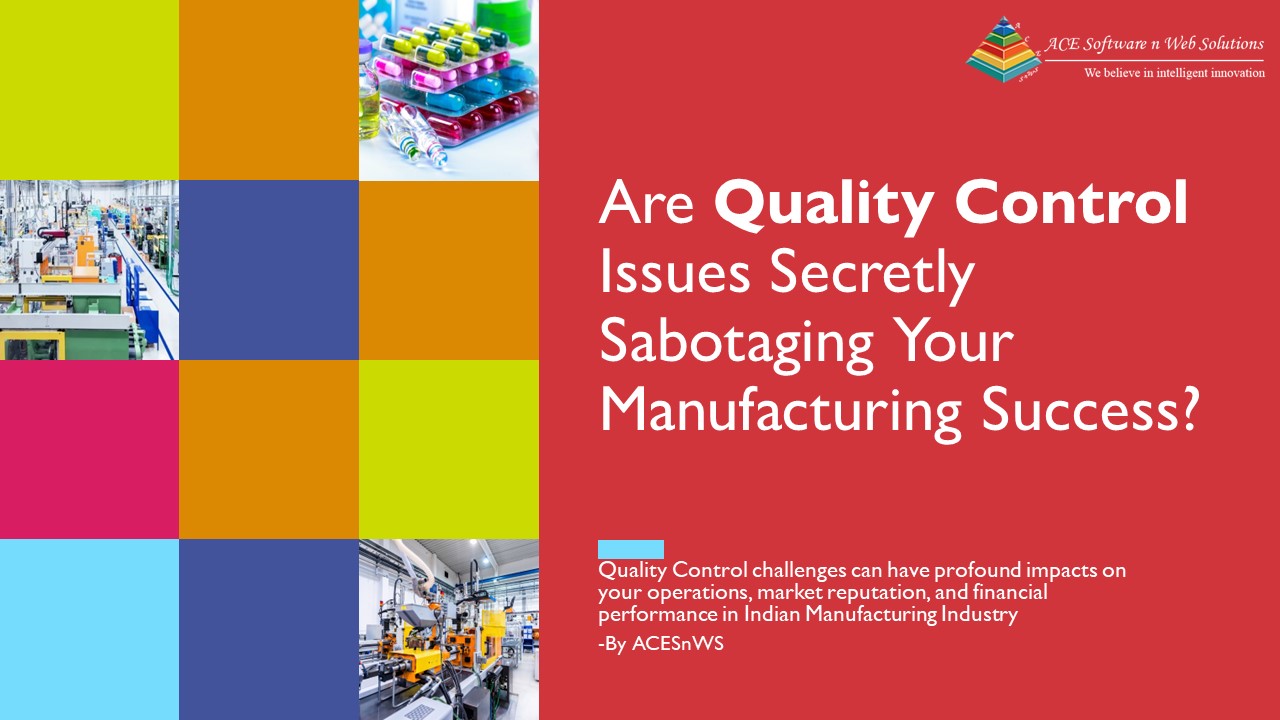
Are Quality Control Issues Secretly Sabotaging Your Manufacturing Success?
CEOs of manufacturing companies in India with turnover ranging from 10 crore to 50 crore often face significant challenges in Quality Control (QC). These challenges can have profound impacts on their operations, market reputation, and financial performance. Here’s a detailed look at the problems, their impacts, and potential solutions:
Problems in Quality Control
- Inconsistent Quality Standards: Small to mid-sized companies may struggle to maintain consistent quality standards due to lack of standardized processes and inadequate training.
- Resource Constraints: Limited financial and human resources can hinder the implementation of comprehensive QC measures.
- Technological Limitations: Many companies in this turnover bracket may not have access to advanced QC technologies and rely on outdated methods.
- Supply Chain Issues: Variability in the quality of raw materials from suppliers can impact the final product quality.
- Regulatory Compliance: Keeping up with national and international quality standards and regulations can be challenging due to the complexities involved.
- Employee Training: Inadequate training and awareness among employees about quality standards and practices.
- Data Management: Poor data management and lack of real-time monitoring can lead to undetected quality issues.
Impact of Quality Control Issues
- Customer Dissatisfaction: Poor quality products can lead to customer complaints, returns, and loss of trust, ultimately affecting brand reputation and customer loyalty.
- Financial Losses: Defective products result in waste, rework, and recalls, which can be financially draining.
- Market Share Decline: Consistent quality issues can drive customers to competitors, reducing market share.
- Legal Consequences: Failure to meet quality standards can result in legal penalties and compliance issues.
- Operational Inefficiencies: Quality issues often lead to disruptions in the production process, causing delays and inefficiencies.
- Increased Costs: Cost of poor quality, including scrap, rework, and warranty claims, can significantly impact profitability.
Solutions to Quality Control Problems
- Implement Standardized Processes:
- Adopt standardized QC processes like Six Sigma or ISO standards to ensure consistency.
- Develop and document Standard Operating Procedures (SOPs).
- Invest in Technology:
- Utilize modern QC technologies such as automated inspection systems, AI, and IoT for real-time monitoring.
- Implement Quality Management Systems (QMS) for better data management and analytics.
- Supplier Management:
- Establish stringent supplier quality agreements and conduct regular audits.
- Develop a robust supplier evaluation and selection process.
- Employee Training and Development:
- Regularly train employees on QC standards, techniques, and the importance of quality.
- Encourage a culture of quality awareness and continuous improvement.
- Regular Audits and Inspections:
- Conduct regular internal and external audits to identify and rectify quality issues.
- Implement random sampling and inspection at various stages of production.
- Customer Feedback Mechanism:
- Establish a system to gather and analyze customer feedback to identify areas for improvement.
- Use feedback to drive continuous improvement in QC processes.
- Regulatory Compliance:
- Stay updated with the latest regulatory requirements and integrate them into the QC processes.
- Engage with regulatory bodies to ensure compliance and avoid penalties.
- Data Management and Analytics:
- Implement robust data management systems to capture and analyze quality data.
- Use predictive analytics to anticipate and prevent quality issues.
- Continuous Improvement Programs:
- Implement programs like Kaizen to foster continuous improvement in quality.
- Encourage cross-functional teams to work on quality improvement projects.
By addressing these problems with targeted solutions, CEOs of manufacturing companies can significantly improve their quality control processes, leading to enhanced product quality, customer satisfaction, and overall business performance.
The percentage improvement in overall working after applying the solutions to quality control issues can vary widely based on several factors, including the specific challenges faced by the company, the industry, and how effectively the solutions are implemented. However, research and case studies from similar initiatives provide some general insights into potential improvements:
Potential Improvements
- Reduction in Defects:
- Implementation of standardized processes and advanced QC technologies can lead to a reduction in defect rates by up to 50-70%.
- Customer Satisfaction:
- Improved quality control can increase customer satisfaction and loyalty, potentially boosting customer retention rates by 20-40%.
- Operational Efficiency:
- Enhanced QC processes and better employee training can improve operational efficiency, reducing production downtime and increasing throughput by 15-30%.
- Cost Savings:
- Reduction in waste, rework, and recalls can lead to significant cost savings, potentially lowering quality-related costs by 20-50%.
- Compliance and Risk Management:
- Better regulatory compliance can reduce legal and compliance-related costs, minimizing risks and associated expenses by 10-30%.
Example Metrics from Case Studies
- Defect Rate Reduction: Companies have reported defect rate reductions of 50-60% within the first year of implementing Six Sigma or similar quality improvement methodologies.
- Cost Savings: Organizations implementing robust Quality Management Systems (QMS) have documented cost savings ranging from 15-45% in quality-related expenses.
- Productivity Gains: Manufacturers leveraging automation and real-time monitoring have seen productivity improvements of 20-35%.
Estimation of Overall Improvement
Considering the combined impact of these factors, a manufacturing company might experience an overall improvement in performance ranging from 20-40% within the first one to two years of implementing these solutions. This estimate includes enhanced product quality, increased customer satisfaction, better operational efficiency, and significant cost savings.
These figures are based on historical data and case studies from various industries. The actual improvement for a specific company will depend on the current state of their quality control processes and how effectively they implement the recommended solutions.


